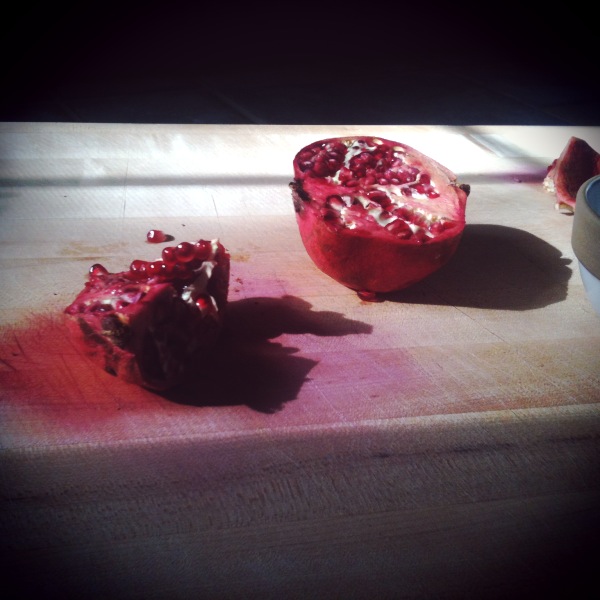Living in a new part of the country means re-learning what “seasonal eating” is. We lucky people who live in the Bay Area are, well, spoiled. Winter doesn’t mean that farmer’s markets are limited to root vegetables, storage squash and the last of autumn’s apples. It means we get to pile all of those things along with many others, on top of fresh new lettuces and greens which, up in Sonoma, finally have enough water and shade to grow. After the searing summer heat and more peppers, eggplants and zucchinis than I ever care to see again, our winter garden is leafy, spicy and growing at the rate of a full salad bowl every other day. Like I said, lucky. When I first lived in the Bay Area, years ago, I worked for a dear friend at The Gardener, in Berkeley. The lessons I learned from her are innumerable, and among them was how to eat a persimmon.
Persimmons are not something I ever encountered as a child in Los Angeles. And of all the produce sent from California to New England, persimmons are seldom seen. Around here they show up at the start of November and stay on through the holidays, lending their festive orange glow to menus and decorative arrangements alike. While sort of intimidating and almost quixotic on the shelf, they are simple to prepare and easily digested by the body. Most importantly, they are delicious, sweet at first bite but without any lingering or excessive sugary taste. My preferred variety is the Fuyu which is squat like a tomato and firm like an apple. These are eaten while still hard and crisp and are delicious in salads, with dry, salty cheeses, or in slices on their own.
Hachiyas, the larger, more oval shaped variety, are eaten soft and ripe when they are practically pudding in the skin. Both varieties are said to soothe sore throats and an irritated intestinal tract and contain enzymes that break down damaged cells and foreign microbes in the body. Pete came home from Sebastopol the other day with a bag full of both kinds so I have been enjoying them every way I can. Most recently I sliced them into this salad of the-best-spinach-I-have-ever-had (it is almost meaty in its richness), escarole and mustard greens. I added pomegranate seeds, another favorite winter fruit.
Pomegranates grow on trees all over town and my friend Emma has been plucking them from her Edenic back yard and bringing them to work, so I eat the seeds in my granola, in salads, dropped in a glass of soda water or prosecco…you get the idea.
Crunchy persimmon, the tart pop of pomegranate seeds, crisp, spicy greens. What’s missing? Oh yeah, cheese. I just discovered how much I love ricotta salata. It has an odd, almost springy texture that I really enjoy. I tossed the whole shebang in good olive oil, juice from half a lemon, and a sprinkle of Maldon sea salt. Now that’s my kind of winter meal.








 Subscribe via RSS
Subscribe via RSS
This comment has been removed by the author.
This comment has been removed by the author.
thANkS Ms. yeNNifeR! I have lots of many of these things: fuyus, pomegranates and spinach (and lemons!), but hadn’t been putting them all together in a salad. Thanks for the inspiration and reminder/new-info about the nutritional benefits of all…
Love you honey bee! xxoo